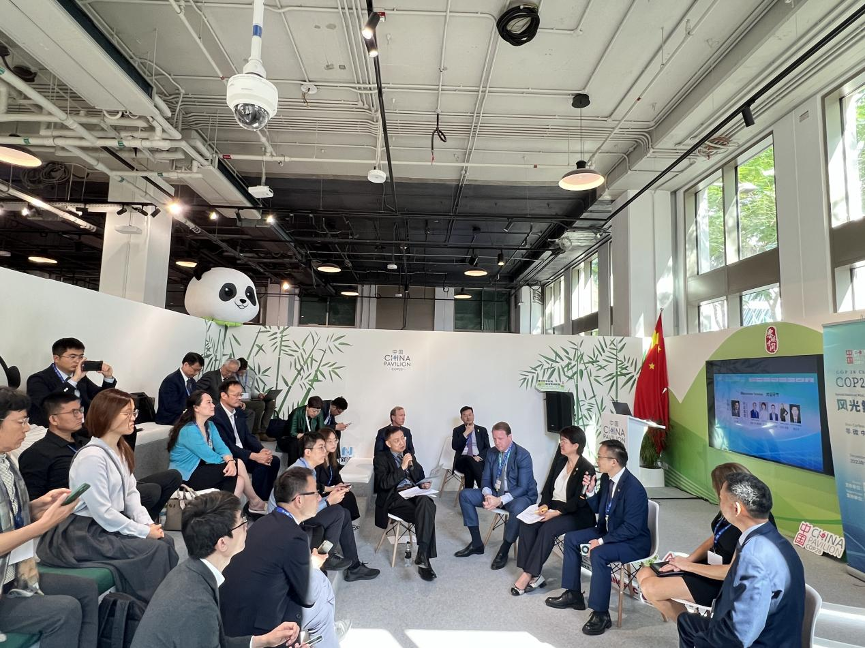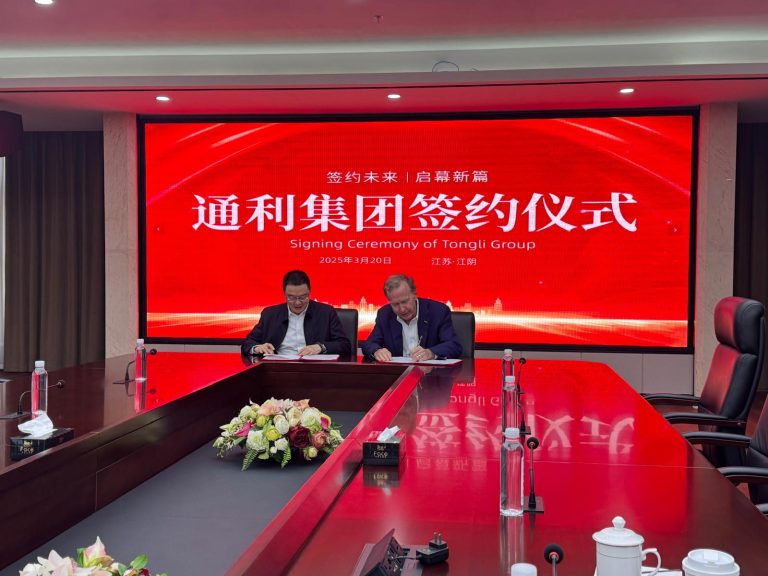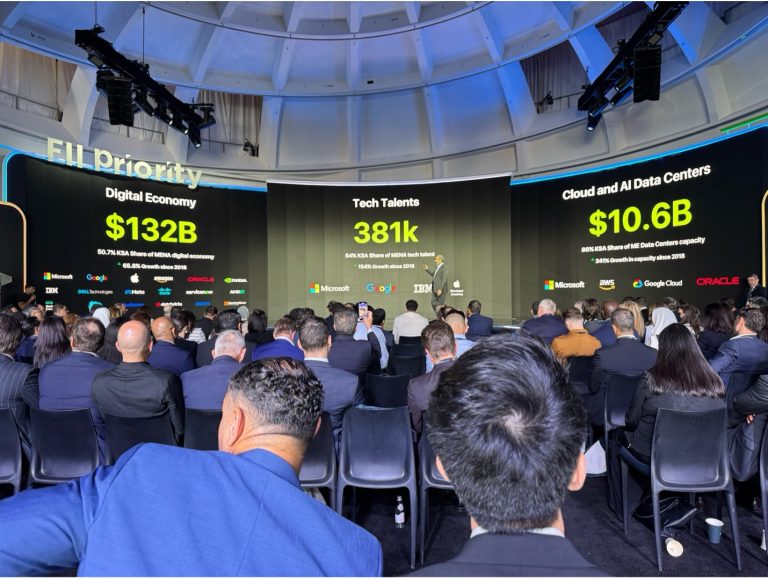During the 28th Conference of the Parties (COP28) to the United Nations Framework Convention on Climate Change, a special conference session on combined renewable solution including Wind, Solar, Hydrogen, and Energy Storage was successfully held at the China Pavilion, organized by the Ministry of Ecology and Environment of China and hosted by Energy Investment Professional Committee (EIPC) of the Investment Association of China (IAC). With the combined vision of Zero Carbon China and Zero Carbon World, the conference focused on energy transition and international cooperation. By exploring integrated zero-carbon energy transition solutions and development models, the conference is pushing towards to accelerate the global carbon neutrality goal.

The conference was presided over by Mr. Eric Fang, the Executive Director of the Energy Investment Professional Committee (EIPC) and Vice Chairman and President of the National Center for Sustainable Development (NCSD). Mr. Fang pointed out that with energy transition takes center stage in the world, both Chinese and international markets are increasingly advocating for an integrated solution model of wind, solar, hydrogen, and energy storage.

The era of “convergence” in renewables including wind, solar, hydrogen, and energy storage is at its infancy, and yet it will certainly gain momentum for the establishment of a new pattern of energy transition as the path to zero-carbon for global carbon neutrality.
Mr. Neil Bush, Chairman of the George H.W. Bush Foundation for U.S.-China Relations, Neil Bush Global Advisers and Skytower Group stated in his address that China, as the largest developing country in the world, has maintained friendly and cooperative relations with the United States. The friendly relations between China and the United States are beneficial to the people of both nations. He expressed the hope that through pragmatic measures, a respectful and friendly dialogue between China and the United States could be achieved, fostering specific international cooperative projects. In his remarks, he used a successful gravity energy storage technology license collaboration between Energy Vault, Atlas Renewable and China Tianying to demonstrate a perfect partnership between China and United businesses. It is perfect example of an innovative technology from United States can take advantage of Chinese manufacturing power to commercialize in a fast pace and leveraging the influence of China’s wind and solar industries, as well as the re-innovation of Chinese enterprises to make gravity energy storage technology rapidly developed and implemented in China, thus providing key reference and experience for subsequent domestic and international new energy storage projects.

Mr. Zhang Jie, Vice President and General Secretary of the Energy Investment Professional Committee (EIPC) of IAC, stated in his speech that achieving zero-carbon transition in energy is key to meeting the temperature control targets of the Paris Agreement. Represented by photovoltaics and wind power, renewable energy in China is accelerating. In the past decade, the cost per kilowatt of wind power projects in China has dropped from 8,000 CNY to about 4,000 CNY, and the cost per kilowatt of photovoltaic power projects from 12,000 CNY to about 4,000 CNY, with reductions of approximately 50% and 70% respectively. In some areas of China, on-grid power tariff of less than 0.1 CNY have been achieved; internationally, in regions like Saudi Arabia, there are precedents for photovoltaic electricity prices as low as 0.01 USD (1 US cent) per KWh. Chinese wind and solar solution providers and manufacturers are increasingly in cooperation with international partners, contributing China’s zero-carbon efforts to the global scale. Ever since EIPC’s focus on “Zero Carbon China Initiative” back in January 2020, it has consistently advocated to move energy industry onto wind, solar, hydrogen, and energy storage combined solution platform. This year, under the “Belt and Road.” Initiative, EPIC has successfully established cooperation with Mongolia and Saudi Arabia supporting the zero-carbon development along with the “Belt and Road” host countries.
Leading The Global Innovation in Wind Power Technology
Mr. Zhang Qiying, President of Mingyang Smart Energy Group Limited, stated that as an extremely low-carbon energy form with excellent climate benefits, wind power is playing a significant role in the global green energy transition.
To achieve sustainable development in human society, it is imperative to embrace the era of ocean civilization. In this regard, Mingyang Smart Energy is leading the way in offshore wind power innovation, venturing into ‘uncharted territories. The company is pushing for the large-scale development of offshore wind power, extending into deeper waters, and pursuing integrated solutions. This endeavor is contributing significantly to the development of the ocean economy.
Harnessing Solar to Create a Green Energy World.
Ms. Xue Weiru, Head of the Market Strategy team of Xi’an LONGi Hydrogen Technology conveyed that in the vigorous promotion of renewable energy applications, LONGi adheres to the “Solar for Solar” philosophy and the development of sustainable ecological models as a leading global solar technology company. The company has committed to using 100% renewable energy for its global production and operations by 2028, demonstrating its competitiveness and sense of responsibility. Concurrently, LONGi is actively strengthening its global presence, continuously contributing the “LONGi Power” through leading technologies to international collaborations. In partnership with international allies, LONGi Hydrogen aims to explore the green hydrogen market, assisting in the achievement of carbon neutrality.

Building a New Ecology for Green Hydrogen
Mr. Li Jiaqiang, Director of the Development Planning Department at Sinopec, shared his thoughts that Sinopec plans to focus primarily on two main areas: hydrogen energy transportation and green hydrogen refining and chemical integration. The company is dedicated to vigorously developing integrated hydrogen energy businesses, fully leveraging the supportive and integrative role of SOEs, and actively promoting high-quality development of the hydrogen energy industry chain.
Integrating Hydrogen with Biogas.
Mr. Zhu Hongguang, Director of the Shanghai Linhai Double Carbon Ecological Research Institute and Head of the Biomass Energy Research Center at Tongji University, introduced the development of the biogas industry from various perspectives, including technological completeness, regional, and full industry chain development. Focusing on hydrogen-to-methane as a path for scientific and technological innovation, he discussed increasing the production capacity of biomethane, exploring new horizons in green electricity storage, and establishing a new system for the production, transmission, storage, and supply of new energy and green hydrogen, based on a station-field style biogas industry.
Journey from Zero-Carbon China to Zero-Carbon World
A roundtable dialogue session, moderated by Eric Fang, Vice Chairman and President of National Center for Sustainable Development, a Washington based 501C3 not for profit organization, where industry experts from China, the United States, and the Nordic-Middle Eastern regions focus their discussions on three core issues. The relationship between the global green energy transition and the integration of wind, solar, hydrogen, and energy storage solution; the transnational cooperation and innovation models and sustainable development and social responsibility. Mr. Guido Frederik, Global Head of Natural Resources at First Abu Dhabi Bank, commented that climate change has profound global implications, particularly in accelerating the rapid development of new energy industries. New energy represents a vast industrial chain and an ecosystem for sustainable development, encompassing sectors like photovoltaics, wind power, hydrogen energy, and energy storage, thereby becoming a focal point of financial capital. As one of the world’s largest international banking institutions, First Abu Dhabi Bank has over a decade of operational history in China. It has consistently promoted green and sustainable development, striving to tilt financial resources towards green and sustainable assets. The bank offers customized services for the diverse financial needs across the upstream, midstream, and downstream segments of the new energy industrial chain. First Abu Dhabi Bank hopes to build international cooperation and contribute to the achievement of the ‘carbon neutrality’ goal together with all.
Ms. Fang Li, the Chief Representative of the World Resources Institute’s Beijing Office, stated that since the initiation of the “Green Belt and Road” projects in 2019, the World Resources Institute has primarily focused on supporting China’s shift from traditional to renewable energy in its overseas energy and power investments. The main content includes two aspects: first, the ‘Green Development Guide’ for the Belt and Road Initiative aims to safeguard the economic returns, environmental benefits, and corporate responsibilities of enterprises and projects. The goal is to enhance the ecological and environmental management standards of foreign investment cooperation projects under the Belt and Road Initiative and guide financial institutions, enterprises, and other stakeholders in green investment practices. Second, to ensure the social responsibility and environmental sustainability of overseas renewable energy investment projects, a concerted effort is required from governments, enterprises, financial institutions, and social organizations. Support from the entire ecosystem is needed, along with mechanisms that allow good practices to yield better returns, to promote a healthy operation.
Mr. Hu Gaofeng, the Deputy Chief Representative of State Power Investment Corporation (SPIC) in South Africa, expressed that as the world’s largest photovoltaic power generation enterprise and the largest developer of new energy, SPIC has expanded its operations into 47 countries globally, with investment projects in approximately 20 nations including three ongoing projects in Saudi Arabia, such as the Saudi Red Sea Integrated Energy Project, which is also the world’s largest off-grid energy storage project. From the perspective of a state-owned enterprise’s social responsibility, SPIC has undertaken new energy projects responsibly and achieved its carbon peak in 2022. Going forward, SPIC is to contribute to the sustainable development of the economy and society through more new energy projects, adopting complementary models of wind-solar, hydro-solar, and multi-energy solutions.
Ms. Sara Norman, the Director of International EPD Strategy and Sustainable Development at the Swedish Environmental Research Institute (IVL Svenska Miljöinstitutet), stated that Sweden has always placed great emphasis on environmental protection and sustainable development. To achieve these goals, the Swedish government and businesses have continually invested funds and resources in clean technology innovation. These innovations span multiple sectors, including energy, transportation, and manufacturing, providing strong support for Sweden’s sustainable development. As one of Europe’s significant renewable energy markets, the growing demand for photovoltaics in Sweden offers broad export prospects for Chinese renewable energy companies. By the end of 2022, Sweden’s photovoltaic installed capacity reached 2.6 gigawatts, and the Swedish government has set a target of 65% of electricity from renewable sources by 2030. This will continue to stimulate demand growth for photovoltaic and wind power technologies and products. Chinese renewable energy companies, by continually enhancing their competitiveness and strengthening international cooperation with Sweden, are well-positioned to promote the sustainable development of renewable energy in Sweden.
Mr. Zang Wenping, Chairman of Tianjin Kimwan Hydrogen Energy emphasized that Tianjin Kimwan has made some breakthrough progress in the development of hydrogen energy. During its development of new carbon graphite material, Kimwan discovered that carbon has a good catalytic effect. Through technological innovation, it is possible to couple wind and solar power for direct hydrogen production through wind and solar energy, an innovation developed in-house leveraging green electricity, green hydrogen, and green chemistry engineering.

In this vibrant and engaging special session, participants from various sectors, including policy, industry, academia, research, and investment, shared the latest advancements and practical experiences in innovative technologies related to wind, solar, hydrogen, and energy storage. These insights provided new perspectives for government, corporate, and investment entities in their decision-making processes for the development of zero-carbon energy. This session facilitated the establishment of a platform in the field of energy science and technology. The integrated development model of wind, solar, hydrogen, and energy storage as a zero-carbon energy solution will undoubtedly contribute significantly to the global goals of carbon neutrality and addressing climate change.



